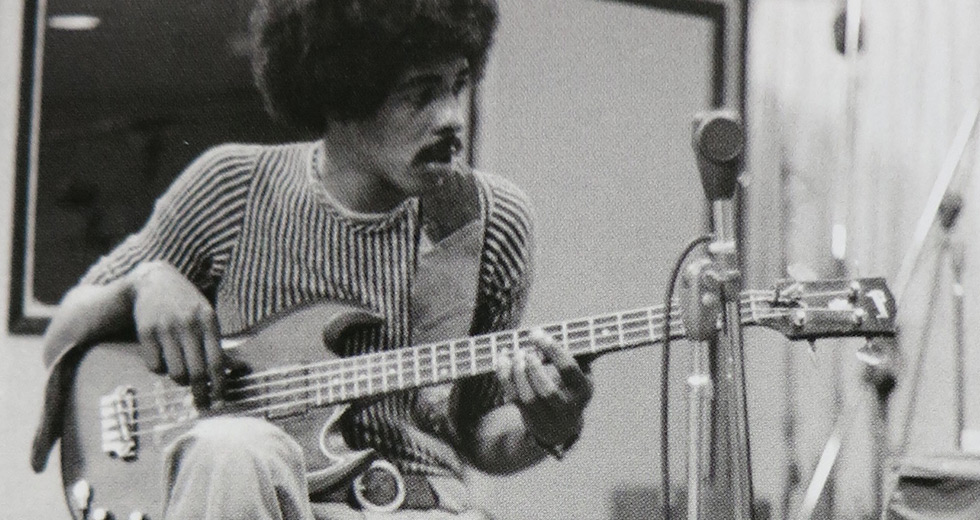The (Not So Clear-Cut) History of the Flying Cymbal
Although often written out of reggae histories, the "flying cymbal" or "flyers" style was a key part of the music’s mid-'70s evolution. Like every other element of reggae innovation, "flyers" has a complex and somewhat contentious history. David Katz untangles the story of the chart-ruling style, revealing earlier precedents that made fleeting impact, and why the hit that made "flyers" famous almost never happened.
It's no secret that Jamaican music is constantly reinventing itself. You can hear it in the posse of young artists that have recently initiated a modern-day roots revival, even as hardcore dancehall mutates into new forms. Such shifts in style were similarly noticeable in the music's formative years: Most casual fans will be familiar with the way that the invigorating sounds of ska emerged as Jamaica prepared for its independence from Britain in the early '60s, only to give way mid-decade to the cooler sound and slower pace of rock steady, which in turn paved the way for reggae.
But it is easy to forget that reggae began as fast-paced dance music, based on an organ shuffle and staccato guitar, before shifting to the slower and more potent sounds of roots, which dominated to the end of the '70s, when the new dancehall style began to emerge. "Flyers" was a key stepping-stone in the process, one of a series of seismic shifts that pointed reggae in new directions.
The style is most strongly associated with the Aggrovators, a spin-off of the Soul Syndicate group, which became the house band commandeered by hit-making producer Bunny Lee. The Aggrovators' main drummer, Carlton "Santa" Davis, claims to have originated the "flying cymbal" form through an adaptation of the "Philly Bump" soul beat developed by Philadelphia studio ensemble Mother, Father, Sister, Brother. If you don’t remember MFSB, or what "Philly Bump" sounded like, cast your mind back to "The Sound Of Philadelphia," which was the theme song of Soul Train – an American TV show, which (not coincidentally) was also a hit with Jamaican viewers. "TSOP"'s most readily identifiably feature was its mechanised backbeat, demarcated by an open-and-closed hi-hat pattern, which percolated under its string, brass and choral arrangements.
"I said, ‘Damn, let’s try that in a reggae sound’... And [then] Bunny Lee wanted it in every song."
According to Santa Davis, the "flyers" style came up during a 1974 jam session, directly inspired by "TSOP," which ultimately yielded Johnny Clarke's breakthrough single, "None Shall Escape The Judgement." As Davis explains, "MFSB, with 'The Sound Of Philadelphia,' they use a lot of that [technique]. The drummer [Earl Young] was a favorite drummer of mine, so I said, 'Damn, let’s try that in a reggae sound.' Then the song 'None Shall Escape The Judgement' came up, and I started the song with that, and Bunny Lee wanted that in every song. He was the one who name it 'flying cymbal,' which is an open-and-closed hi-hat. Then the whole thing started ballooning."
"None Shall Escape The Judgement" nearly got left in the can. It was written by Earl Zero, an aspiring ghetto singer that was friendly with Aggrovators guitarist Earl "Chinna" Smith, and who, like Smith, lived close to Bunny Lee's bourgeoning Greenwhich Farm headquarters. After Lee heard the pair practicing songs together in the neighbourhood, he brought Zero to Treasure Isle studio to record "None Shall Escape The Judgement," using upcoming singer Johnny Clarke for backing vocals (since Clarke was then causing a buzz in England with "Everyday Wondering," cut shortly before for rival producer Rupie Edwards), along with another youth whose name has been lost to the passing of time. But when the recording session was finished and Lee listened back to the master tape, he felt Zero's vocal delivery needed improvement. He thus approached the better-established singer Cornell Campbell, but Campbell declined to voice a new version of the tune, since Lee owed him money for previous work. Bunny then drew back for Johnny Clarke, who voiced an alternate lead vocal on the rhythm at King Tubby's studio, tackling the tune with considerable aplomb and the kind of naturalness that suggested he'd written the foreboding lyrics himself.
The resultant "None Shall Escape The Judgement" became a massive hit for Clarke and a sensation in both Jamaican and Britain, leading not only to further cuts on the rhythm, such as Clarke's "Joshua's Word," and the Vin Gordon trombone instrumental "Magnum Force" (and later, to Jonathan Richman's "Egyptian Reggae" hit in the USA), but also to a series of "clashing" discs between Clarke and Campbell. Among the most impressive tracks to result from the feud were Campbell's "The Gorgon," "A Dance in a Greenwich Farm," "Gun Court Law" and his reggae rendition of "Duke Of Earl," along with Clarke's "Move Out Of Babylon Rastaman," "Enter His Gates With Praise" and "Rock With Me Baby." The "flying cymbal" was the outstanding element of all these songs, yet Clarke suggests its initial implementation on "None Shall Escape The Judgement" was highly spontaneous.
"Santa was there just playing the cymbal a little, and Bunny came in and said, 'Oh, boy! That's what we want!' Normally Santa was just doing it as a joke, a little workout thing to loosen up himself before we get into the real thing. But it end up that the loosen-up becomes real – a new sound!"
"Santa was just doing it as a joke, a little workout thing to loosen up himself before we get into the real thing. But it end up that the loosen-up becomes real – a new sound!"
As the "flying cymbal" rapidly dominated the charts, other producers soon got in on the act, with Lee Perry using it for "Kiss Me Neck," Linval Thompson's "Kung Fu Man" and his own rendition of the Soul Train theme as "Rebels Train." Producers like Alvin "GG" Ranglin even started making use of Treasure Isle studio, hoping to capture some of the same magic. "Bunny Lee had the sound, and everybody wanted to go to Duke Reid's studio," notes Clarke, "because different producers always watch another producer, and if you go to a studio and they see you get a hit sound, they want to go there too. Everybody was doing cymbal, and a lot of the artists who never had that on their trend, they started following our way, because that was the hit way, what the people needed. If you see a way that money's going to make, you're going to go with it, and the cymbal was good money with the sales. Without sales, you're a loser, waste your time."
Away from the charts, "flyers" was an equally important component of the evolving dub scene, with King Tubby making full use of its musical spectrum on classic albums such as Dub From the Roots and The Roots of Dub, honing in on the "styling cymbals" that characterized it (as mentioned in the liner notes of the former LP).
A closer examination, though, reveals that "flyers" wasn’t really a new invention in 1974. On the contrary, as was the case with the "version" phenomenon, it seems that "flyers" took time to find favor in Jamaica, with its first few instances causing interest, but not making enough of a lasting impression for the style to yet become predominant. Renowned drummer Sly Dunbar recently pointed out that the "flying cymbal" style dates back to at least as early as the 1968 recording "Moonlight Lover," which American singer Joya Landis voiced for Duke Reid, and feels it may have first been employed in ska. "Flying cymbal style wasn't created by the Soul Syndicate band," he insists. "I first heard that flying cymbal in 'Moonlight Lover' and I don't know who was playing that drum, but if you listen to the Skatalites' stuff, Lloyd Knibb is playing something like that too. And it was something like, MFSB got it from us, personally. 'Moonlight Lover' came out before 'TSOP.'"
"I first heard that flying cymbal in 'Moonlight Lover'... MFSB got it from us."
Dunbar says "Moonlight Lover" inspired him to adopt the style while leading the club act Skin, Flesh and Bones, who scored a proto-flyers hit in 1973 with Al Brown's reggae rendition of Al Green's "Here I Am Baby (Come And Take Me)," released on Dickie Wong's Tit For Tat label. "Then Bunny Lee realize that the style was working," Dunbar emphasizes, "and he took it and started calling it the 'flying cymbal.'"
Regardless of its origins, the "flying cymbal" was all the rage in Jamaican music, until the "rockers" style, which largely resulted from rhythmic innovations Sly Dunbar instigated at Channel One, obliterated it. "Rockers" rendered "flyers" distinctly passé, the new rhythmic propulsion ultimately helping Jamaican music to reach a pinnacle of international popularity during roots reggae's subsequent heyday. But that's another story...

